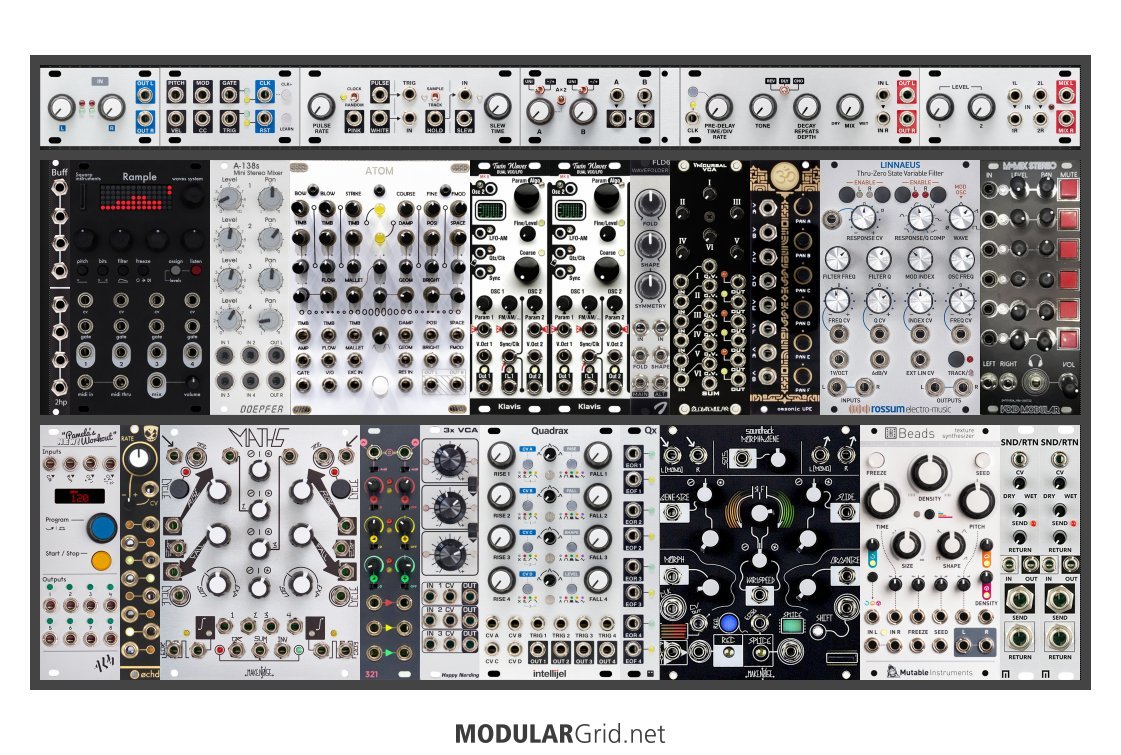There's a number of problems here...for one thing, the tile row is a wreck. There's two tiles that aren't Intellijel-format, for starters. Then there's all of the I/O modules and extra jacks, which I'm not able to make sense of since the case in question already HAS the necessary jacks. If they're an attempt to integrate pedals, they're the wrong one.
Intellijel makes a specific tile for this, their Pedal I/O 1U, which utilizes the case's jacks. But using the line-level tiles currently in the build won't work well, as both the impedance and level for stompbox inputs is very different from typical line-level signal requirements. A far better result can be had with 3U modules that are specifically for pedals, something like Adventure Audio's Merge, which not only provides proper send-return capabilities, it ALSO adds CV control functions over the module, serves as an external preamp, and comes with an envelope follower so you can use extracted amplitude information to control other modules.
Now, as for the Lifeforms...yep, spot on, I'm going to tell you that it doesn't belong in there. But I'm going to explain one of the critical "whys" as to why that is...
Your Lifeforms module costs $649, takes up 48 hp.
The Intellijel cab costs $649 as well, and has 208 hp of 3U space. Without taking the tiles into account, this means your 3U spaces cost $3.12 each.
3.12 x 48 = $149.76 is the amount (more or less) you have to add to the Lifeforms' cost if you continue to house it in the Intellijel cab. Since I'm pretty sure that an SV-1 never streets for a hair under $800, which is what you get here, it becomes obvious that the convenience of this might not justify the cost. Plus, you admit you're short on space for things...but once you put the SV-1 back where it belongs, you've got space.
Hm...let's mess with this...lessee...

OK...this got a LOT of reworking done to it. There was a lot in the previous build that could be handled better with the use of multifunction modules, one example being the pair of Klavis Twin Waves, which contain a pair of VCOs each, plus quantization, internal VCO sync, and some other surprises. This is key to Eurorack; since a typical build contains a comparatively small amount of space, multifunction modules are essential.
Tile row: This was fixed so that everything goes to the onboard jacks. The outboard stuff in here was moved, then the row was totally rebuilt so that it contains clocking, S&H, noise, a dual attenuverter/mixer, some FX, and a 2-in stereo mixer/output so that you can fly effects in over the main mix.
Top 3U: Buffered mult, as there's a LOT of pitch CV splitting possible here. Then the Rample, and after that is a 4-channel stereo mixer to sum the Rample's outs down to a single stereo pair. Mashed the Elements clone a little more, then you've got the Klavis VCOs, and a Joranalogue Fold6, a rather neat wavefolder in which you can "throw" two oscillator outputs at each other to sort of "cross-warp" them. After this is a Zlob Vnicvrsal Hex VCA to control the levels from the ATOM and Klavises, or you can opt to apply this to the Rample's mixer output, or...well, you get the idea. After that, an Omsonic unity gain panning mixer sums all of that down to a stereo pair. I went with a seriously over the top VCF, and since we're now purely in stereo, why not a stereo VCF? Hence the Rossum Linneaus...not at all conventional, and definitely potential-packed...including the ability to thru-zero it. Void Modular's M+Mix Stereo gives you six pannable inputs at the end of the voice chain, and this patches to one of the stereo pairs at the output mixer tile...leaving the other stereo pair for flying in the several processing options over the master mix.
Bottom 3U: Pam's...no sequencers here, but Pam's has a lot of other tricks up its sleeve. Then the Ochd, and yes, Maths. Sure, it's big. But it's a proven quantity as far as a modulation generator, and is just about perfect for this since it has SO MANY options. Then a Frap 321 and a Happy Nerding 3xVCA give you some crossmod capabilities, also with the assistance of the Quadrax/Qx combo. Then for FX, the Morphogene (obvious pick!), the Beads, and two Malekko SND/RTN modules for external processors. These also offer CV over wet/dry balance, which also has its own abuse potential.
Lots of other stuff got tossed, most of that being due to my work on trying to up the functional capabilities. Really, you don't want single-function devices in a small build like this, and so I attempted to make this VERY much an exploratory build for sound creation by cramming in those multifunctions, putting modules back that synergize with other modules (Maths!) and the like. Result actually has LESS modules than before, but those less modules are actually capable of MORE than the original, especially given that some of the utility bits got tailored to work with other modules...definitely a 1 + 1 = 5 sort of result!

